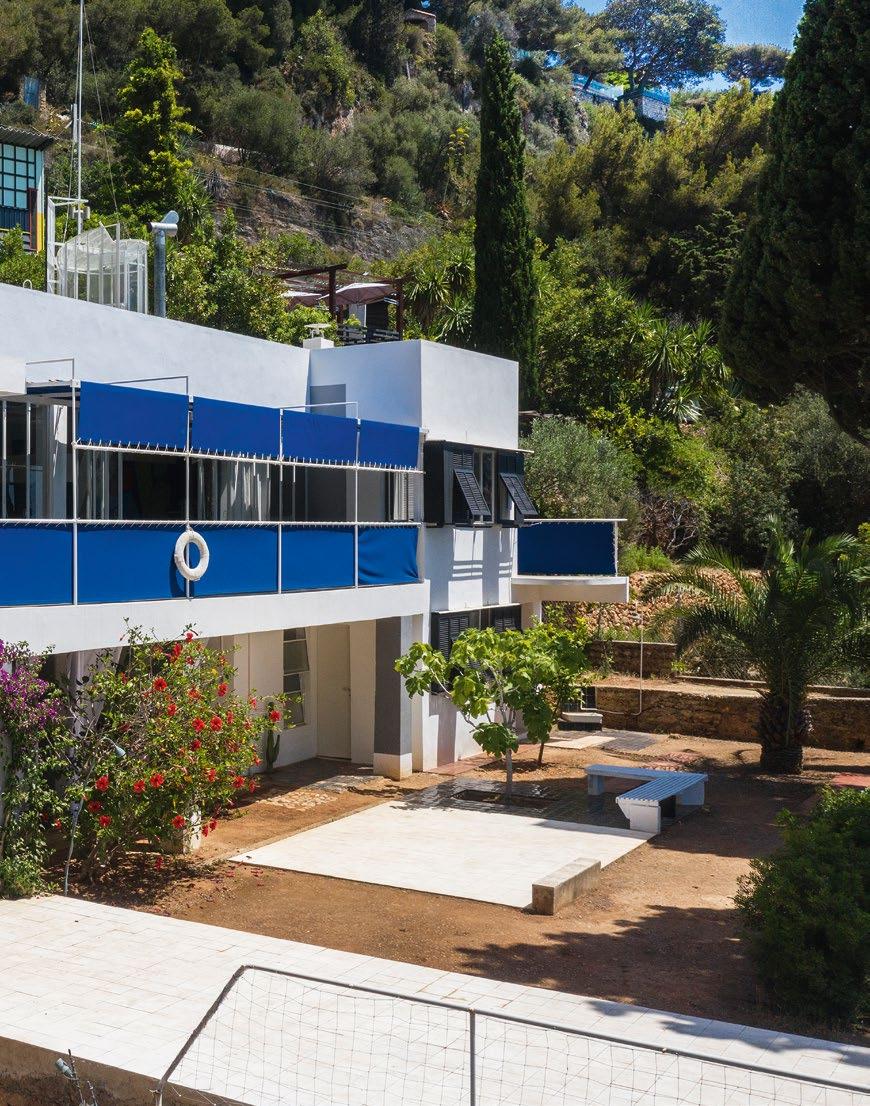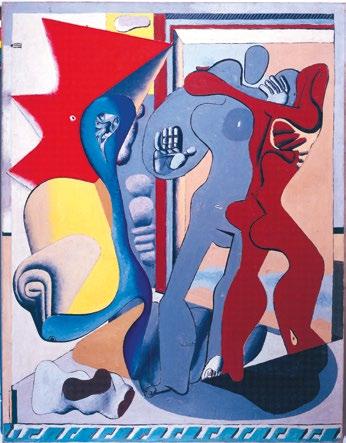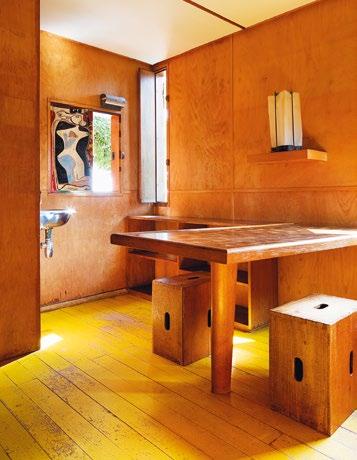 Tim Benton
Tim Benton
 Tim Benton
Tim Benton
THE PAINTER
EILEEN GRAY’S VILLA E 1027 AND LE CABANON
Photography by Manuel BougotFOREWORD
9 Antoine Picon
LE CORBUSIER, ART AND THE WALL
22 Le Corbusier and the wall | 26 Monumental painting
28 The artist Le Corbusier | 35 The Pavillon des Temps Nouveau | 38 Mural painting | Fernand Léger and Le Corbusier: a constructive dialogue | 43 The revelation of de Stijl
48 Mural art as propaganda | 53 Medieval art: model for mural painting? | 54 Renaissance art: model for a total work of art? | 54 In praise of public art | 56 Tapestries: itinerant mural paintings? | 56 The first mural: Léger, Vézelay and Badovici
61 Excursus: The mural in the Rue Le Bua
PAINTING IN THE VILLA E1027
64 The first two murals in E1027 | 70 The ‘sgraffitte’ under the pilotis | 72 The paintings of August 1939 | 77 The mural to the right of the entrance | 77 Still life at the entrance to the guest room | 78 The mural at the entrance | 82 The mural in the guest room | 83 The mural in the bar | 86 Aggression? |
93
 Camping units by Le Corbusier
The site at Roquebrune-CapMartin, photo 2021.
Camping units by Le Corbusier
The site at Roquebrune-CapMartin, photo 2021.
 Villa E 1027
Le Corbusier’s cabanon
Restaurant Étoile de mer
Villa E 1027
Le Corbusier’s cabanon
Restaurant Étoile de mer
 Eileen Gray and Jean Badovici, E1027, the ‘Villa by the sea’, 1926–1929, with Le Corbusier’s camping units in the background.
Eileen Gray and Jean Badovici, E1027, the ‘Villa by the sea’, 1926–1929, with Le Corbusier’s camping units in the background.


LE CORBUSIER, ART AND THE WALL
Le Corbusier first visited E1027 at the end of March 1937.1 The house in RoquebruneCap-Martin had been designed in large part by the brilliant Irish designer Eileen Gray and constructed between 1927 and 1929.2 The name encodes the initials ‘E’ and ‘G’ (7th letter of the alphabet) enclosing ‘J’ and ‘B’ (tenth and second letters of the alphabet), standing for the initials of her own name and those of her friend and partner at the time, Jean Badovici. There is also a marine reference: local boats were identified by four figure numbers beginning with ‘E’. In the autumn and winter 1929 edition of the journal that Badovici edited, L’Architecture Vivante, the house was given extensive coverage.3 Between 16 June and 5 July 1926, Gray had already purchased another house and adjoining plots of land, on the hills above nearby Menton, not far from Roquebrune-Cap-Martin, and began restoring it.4 She called this house near the village of Castellar ‘Tempe a Pailla’, the name drawing upon the Provencal proverb ‘Avec le temps et la paille, les nèfles mûrissent’.5 After breaking up with Badovici, she moved into this house around 1932 and apparently never revisited E1027, although she remained friendly with Badovici and collaborated with him on a number of projects. Badovici helped her with the builders during the construction of her villa Tempe a Pailla and again after the war when the villa had to be restored after vandalisation by German troops.
On or just after 25 April 1938, just off the boat after a trip to Algeria, Le Corbusier joined his wife Yvonne and his friend Jean Badovici in E1027. Before returning to Paris on 1 May 1938, he painted two mural paintings, one in the living room and one underneath the
1 Mentioned in a letter from Pierre Guéguen to Jean Badovici on 14 April 1937 (Getty Research Institute, Los Angeles, Badovici archive 880412, Box 6).
2 Badovici purchased the site on 27 March 1927 (Conservatoire des hypothèques de Nice, 2e bureau: deed 67, vol. 140, no. 86, first cited by R. Stella (2017). ‘Where the Paper Trail Leads’, in W. Wang (ed.), E.1027 Eileen Gray, Austin, University of Texas Press, pp. 92–99. A preliminary agreement for this purchase dated 8 March 1926 is in the Renaud Barrès and Mireille Rougeot archive. It is likely that Eileen Gray subsidised the purchase, but the house always belonged to Badovici.
3 For a facsimile edition of this volume: Jean Badovici, Eileen Gray et al. (2015). E 1027 maison en bord de mer [textes liminaires par Jean-Paul Rayon, Jean-Lucien Bonillo, Pierre-Antoine Gatier], Marseille, Éditions Imbernon.
Detail of Le Corbusier’s mural at the entrance to E1027, with Eileen Gray’s stencilled message Entrez lentement (Enter slowly).
4 Stella, R. (2017). ‘Where the Paper Trail Leads’, op. cit., p. 92. Gray designed a new set of furniture for Tempe a Pailla. See P. Adam (2009). Eileen Gray. Her Life and Work, London, Thames & Hudson, pp. 119–126 and 218–243.
5 ‘With time and straw, the loquats ripen’, a reference to the time it takes for ideas to mature. Caroline Constant (2020). ‘Tempe a Pailla and Lou Pérou: The Architectural “Soul” of Eileen Gray’, in Cloé Pitiot and Nina Stritzler-Levine (eds.), Eileen Gray, New York, Bard Graduate Center, p. 206.

berg.19 The magazine L’Esprit Nouveau, which they edited from 1920 to 1924, helped, as did the two books on art that they published: Après le Cubisme (1918) and La Peinture moderne (1925).20 These books gave a theoretical structure to their work which was broadly consistent with the theories of modern architecture proposed in Vers une Architecture (1923). They stressed precision and geometrical proportion and preferred everyday, industrially produced objects for their subject matter.
Following his split from Ozenfant in 1925, however, Le Corbusier virtually stopped exhibiting. And his painting moved away from the great themes of modernity, industrialisation and standardisation. His centre of inspiration moved from the city to the coast, from Paris to the Bassin d’Arcachon, where he and his partner Yvonne Gallis took their holidays every year from 1926 to 1936.21 He became fascinated with natural objects – seashells, fragments of driftwood,
19 The first exhibition by Ozenfant and Jeanneret was held at the Galerie Thomas on 22 December 1918. A second exhibition at the Druet gallery (January–February 1921) was enthusiastically reviewed by the critic Maurice Raynal. Léonce Rosenberg went on to invite the two artists to contribute to an exhibition at the Galerie de l’Effort Moderne (2–25 May 1921) alongside the work of Picasso, Braque, Gris and other Cubist artists. Rosenberg also included their work in exhibitions in Amsterdam and Barcelona.
20 Ozenfant, A. and C. E. Jeanneret (1918). Après le Cubisme, Paris, Éditions des Commentaires; and A. Ozenfant and C. E. Jeanneret (1925). La Peinture moderne, Paris, Éditions G. Crès et Cie.
21 Benton T. and B. Hubert (2015). Le Corbusier. Mes années sauvages sur le bassin d’Arcachon Paris, Ibep; and T. Benton (2013). ‘Atlantic Coast: Nature as Inspiration’, in J.-L. Cohen (ed.), Le Corbusier: An Atlas of Modern Landscapes, New York, Museum of Modern Art, pp. 162–167.
Le Corbusier, Femme grise, homme rouge et os devant une porte (Grey woman, red man and bone before a door), 1931.

Le Corbusier, Le déjeuner près du phare (Lunch near the lighthouse), 1928.


PAINTING E1027
To believe the received historiography, Le Corbusier visited E1027 (ironically termed ‘baraque’)93 regularly in the 1930s. However, a detailed study of his diaries and correspondence demonstrates that he visited only once before 1938. He wrote to Marguerite Tjader-Harris about this trip in March 1937, and his presence was confirmed in a letter from Pierre Guéguen to Badovici on 14 April 1937.94 In his diary, he noted the train times to Roquebrune.95
But Roquebrune was not the only place on the Côte d’Azur that Le Corbusier and Yvonne visited. On at least two occasions they stayed with Madame Pégurier, for whom Le Corbusier had offered to design a villa.96 Two letters addressed to Le Corbusier and Yvonne at her villa in St Tropez from July 1928 are evidence of these visits.97 It was during this stay that Le Corbusier suffered his terrible accident while swimming in the harbour. A speedboat ‘made mincemeat’ of me, as Le Corbusier said. The prow of the boat split open his skull and the propeller gashed his thigh | ill. p. 74 |. He spent thirty-three days in hospital and wrote detailed accounts of his experience to his mother.98 Referring to his thigh, he told his mother that the wound was ‘as long as La Ville Radieuse’ (his book):99
From six in the evening on Saturday the 13th until nearly midnight I was cut up, sewn up and hammered by the sawbones, without anaesthetic. The doctors complimented me.100 This accident, which Le Corbusier referred to as the ‘miracle of St Tropez’ had a profound effect on him, to the point that, three years later, he introduced the manuscript of his book on urbanism – Sur les quatre routes – with a detailed description of the event.101 He explains
93 Le Corbusier and Badovici used the ironic title ‘baraque’ (shack) to describe Eileen Gray’s finely articulated villa. It is important to note, however, that ‘baraque’ had a privileged connotation in Le Corbusier’s vocabulary, signifying not only the simple vernacular structures that he greatly admired around the Bassin d’Arcachon, but also the cabin on Long Island where he and Marguerite Tjader-Harris consummated their affair in November 1935. In his letters to her for years after, he asks after the ‘baraque’, referring not to the structure but to the memory of their experience together.
94 FLC E3(10)28 and Getty Research Institute, 880412, Box 6.
95 (FLC F3(6)4 folios 9v and 10r.
96 In a letter to Mr Steele, Le Corbusier mentions these visits, 13 May 1937 (FLC I1(1)133).
97 See R. Baudoui and A. Dercelles, eds. (2013). Correspondance. Lettres à la famille, op. cit., p. 582. The letter from Mr G. Pellerson, of 19 July 1928, was redirected to Madame Pégurier’s address in St Tropez.
98 23 August (FLC R2(1)263) and 21 September 1938 (FLC R2(1)264).
99 FLC R2(1)263.
Entrance to E1027, with Eileen Gray’s lamp and letterbox and Le Corbusier’s mural painting.
100 Ibid.
101 FLC B3(12)242 ff. The editor of the book, Jean Paulhan, cut this passage but Le Corbusier later tried to reinsert it. See Guillemette Morel Journel (2010). Le Corbusier, l’écrivain: arpenter sur les 4 routes, PhD thesis directed by Prof. Jean-Louis Cohen, Paris, EHESS, 17 December 2010.

and the Pythagorean – by a wooden wall. At Le Piquey, Le Corbusier had sketched some women dancing animatedly to the sound of a gramophone at the ‘Baron’ cinema run by one of the members of the Vidal family | ill. p. 83 |.137 On 28 August 1932, he wrote: Baron is popular because his ‘pickup’ is up to date. Waltzes, javas, accordion etc. Le Piquey is having a ‘good time’: Youth and joy everywhere.138
The figure on the left is clearly derived from a rough drawing in Sketchbook B6. Le Corbusier reproduced the two parts of this painting in his later Poème de l’angle droit in the section B2 Esprit. 139

In Le Corbusier’s later invention of the Modulor (published as a book in 1950), he tried to bring together golden section proportions (the Fibonacci series) with dimensions related to the human figure. In the Poème, a lithograph of the Modulor follows, with the twin Fibonacci scale in the middle, flanked by the seashell on the right and the Modulor man on the left.
137 See sketchbooks B6, pp. 399–404 and B8, pp. 520–522, in Le Corbusier et al. (1981). Le Corbusier Sketchbook, New York and Cambridge, Mass., Architectural History Foundation and MIT Press.
138 Sketchbook B8, ibid, p. 506.
139 Le Corbusier (1955). Poème de l’angle droit, op. cit., folios 52 and 54.



S. 120
| top | Le Corbusier, cabanon, with Yvonne’s bed on the right, 1952.

| bottom left | Le Corbusier, cabanon, 1952. The furniture was designed by Jacques Michel and con-
structed by Charles Barberis who also manufactured the prefabricated elements of the cabanon.
| bottom right | Le Corbusier, cabanon, 1952. The red curtain hides a WC.
S. 121
| top left and right | Le Corbusier, paintings on the window shutters of the cabanon.

| centre left | Le Corbusier, the five compositions on the
interior wall of the cabanon.
| bottom right |
Le Corbusier, the five compositions on the interior wall of the cabanon, above Le Corbusier’s bed.


ACKNOWLEDGEMENTS
The author would like to thank Robert and Magda Rebutato for their stimulus and support in the preparation of this book.
Stéphanie Gregoire and Caroline Maniaque played key roles in the refinement of the original French text, as did Ria Stein for this English edition. Without the photographs of Manuel Bougot this book would have lost much of its impact. The Centre des monuments nationaux were helpful in providing permission to take photographs on the site.
Jennifer Goff and the National Museum of Ireland were generous in their support.
Michel Richard and Brigitte Bouvier, successive directors of the Fondation Le Corbusier, made the publication possible. Arnaud Dercelles and Isabelle Godinot, also from the Fondation Le Corbusier, provided quick and professional responses to requests for documents.
GRAPHIC DESIGN, LAYOUT AND TYPESETTING
e o t . Büro für Buchgestaltung/ Ausstellungsdesign
COPY EDITING AND PROJECT MANAGEMENT
Ria Stein
PRODUCTION
Anja Haering
PAPER
Magno Volume 135 g/m²
PRINTING
Grafisches Centrum Cuno GmbH & Co. KG, Calbe
This book is based on the French original edition Le Corbusier Peintre à Cap-Martin which was first published in 2015, with a second edition in 2021.
For the original edition:
© Editions du patrimoine – Centre des monuments nationaux, Paris, 2015 and 2021
The French original edition of this book was enabled by Cap Moderne Association, Fondation Le Corbusier, Centre des monuments nationaux, Conservatoire du littoral and Association culturelle Eileen Gray. Etoile de Mer. Le Corbusier.

Library of Congress Control Number: 2022951093
Bibliographic information published by the German National Library.
The German National Library lists this publication in the Deutsche Nationalbibliografie; detailed bibliographic data is available on the Internet at http://dnb.dnb.de.

This work is subject to copyright. All rights are reserved, whether the whole or part of the material is concerned, specifically the rights of translation, reprinting, re-use of illustrations, recitation, broadcasting, reproduction on microfilms or in other ways, and storage in databases. For any kind of use, permission of the copyright owner must be obtained.
ISBN 978-3-0356-2653-7
e-ISBN (PDF) 978-3-0356-2657-5
This book is also available in a German language edition with the title
Le Corbusier – Der Maler. Eileen Grays Villa E1027 und Le Cabanon, print-ISBN 978-3-0356-2654-4.
For the English and German edition: © 2023 Birkhäuser Verlag GmbH, Basel P.O. Box 44, 4009 Basel, Switzerland
In 1929, Eileen Gray designed Villa E 1027 for herself and her youthful partner Jean Badovici, but only lived there for three years. Today, the elegant house in Roquebrune-Cap-Martin in southern France is an icon of modernism. In 1937, Le Corbusier discovered the place and the ‘Maison en Bord de Merʼ. Inspired by the genius of the place and the light on the Côte dʼAzur, he created a total of eight large-format wall paintings there in 1938 and 1939, some of which complement the building congenially, while others set counterpoints. In 1952, he built his cabanon nearby and decorated it with murals as well. The book by the well-known architectural historian Tim Benton documents Le Corbusierʼs artwork at this special place, explores its controversies and places it in his overall œuvre.



